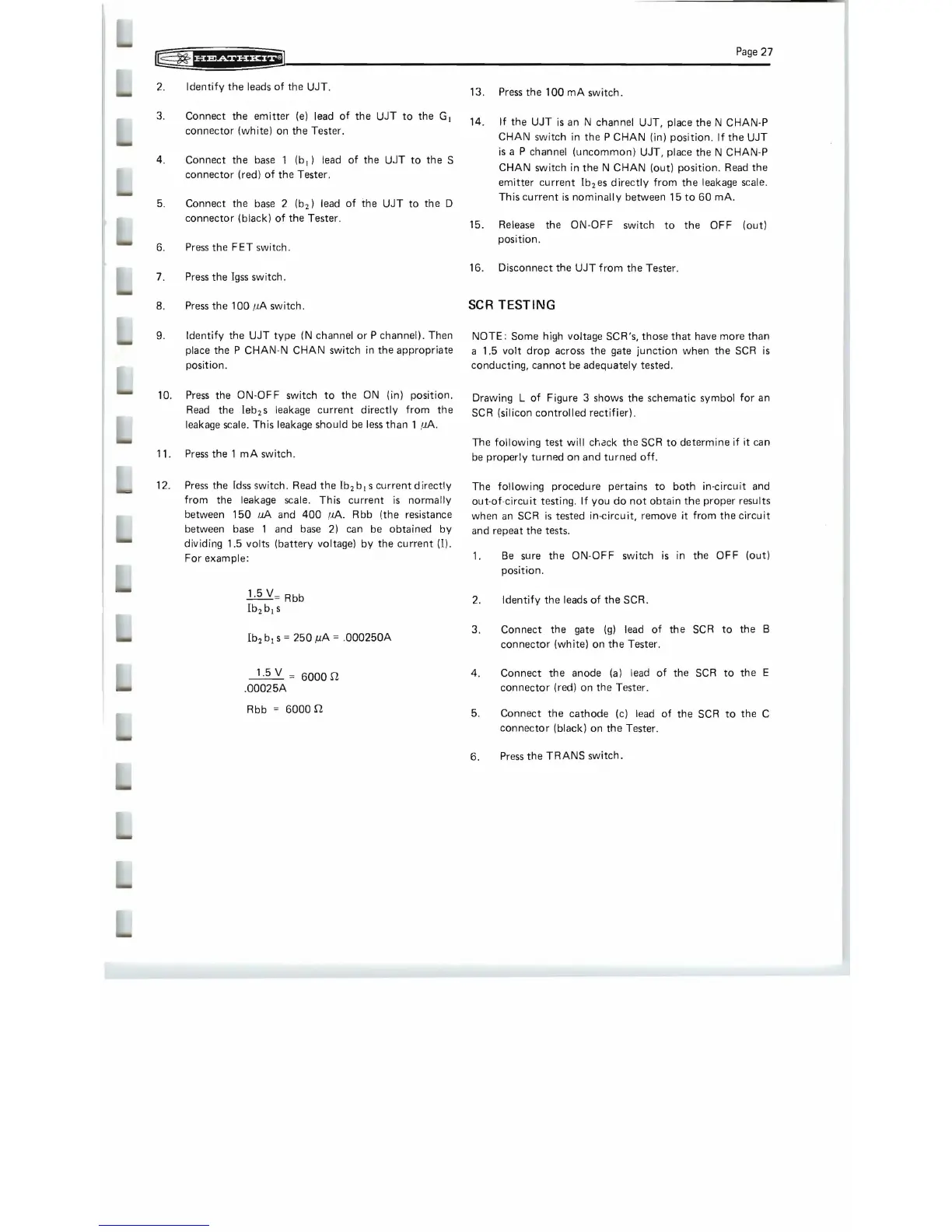Page
27
2.
Identify
the
leads
of
the UJT.
3. Connect the
emitter
(e)
lead
of
the
UJT
to
the G I
connector (white) on the Tester.
4.
Connect the
base
1 (b
l
)
lead
of
the
UJT
to
the
S
connector (red)
of
the Tester.
5.
Connect the
base
2
(b
2
)
lead
of
the
UJT
to
the D
connector (black)
of
the Tester.
6.
Press
the F
ET
switch.
7.
Press
the
Igss
switch .
8.
Press
the 100
/lA
switch.
9.
Identify
the
UJT
type
(N
channel
or
P channel). Then
place the P
CHAN-N
CHAN
switch in the appropriate
position.
10.
Press
the ON-OFF switch
to
the ON (in) position.
Read
the Ieb
2
s leakage
current
directly
from
the
leakage
scale.
Th
is
leakage should
be
less
than 1 !1A.
11.
Press
the 1
mA
switch.
12.
Press
the Idss switch.
Read
the Ib
2
b I S
current
directly
from
the leakage scale. This current
is
normally
between
150
flA
and
400
riA. R bb (the resistance
between
base
1 and
base
2)
can
be
obtained
by
dividing 1.5 volts (battery voltage)
by
the
current
(I).
For example:
1.5 V= Rbb
[b
2
b
l
s
[b
2
b
l
S
=
250
/lA
=
.000250A
~=
6000n
.
00025A
Rbb =
6000
n
13.
Press
the
100
mA
switch.
14.
If
the
UJT
is
an
N channel UJT, place the N CHAN-P
CHAN
switch in the P
CHAN
(in) position.
If
the
UJT
is
a P channel
(uncommon)
UJT, place the N CHAN-P
CHAN
switch in the N
CHAN
(out) position.
Read
the
emitter
current
Ib
2
es
directly
from
the
leakage scale.
This
current
is
nominally
between 15
to
60
mAo
15.
Release
the ON-OFF switch
to
the
OFF
(out)
position.
16. Disconnect the
UJT
from
the Tester.
seR
TESTING
NOTE:
Some high voltage SCWs, those
that
have more than
a 1.5
volt
drop
across the gate
junction
when the
SCR
is
conducting, cannot
be
adequately tested.
Drawing L
of
Figure 3 shows the schematic symbol
for
an
SCR
(silicon
controlled
rectifier).
The
following
test
will
chack the
SCR
to
determine
if it
can
be
properly
turned
on
and
turned
off.
The
following
procedu
re
pertains
to
both
in-circu
it
and
out-of-circuit
testing.
If
you
do
not
obtain
the
proper results
when
an
SCR
is
tested in·<:ircuit, remove
it
from
the
circuit
and repeat the tests.
1.
Be
sure the ON-OFF switch
is
in the OFF
(out)
position.
2.
Identify
the leads
of
the
SCR.
3.
Connect the gate
(g)
lead
of
the
SCR
to
the B
connector (white) on
the
Tester.
4.
Connect
the
anode
(a)
lead
of
the
SCR
to
the
E
connector (red) on the Tester .
5.
Connect the cathode (c)
lead
of
the
SCR
to
the C
connector (black) on
the
Tester.
6.
Press
the
TRANS
switch.
